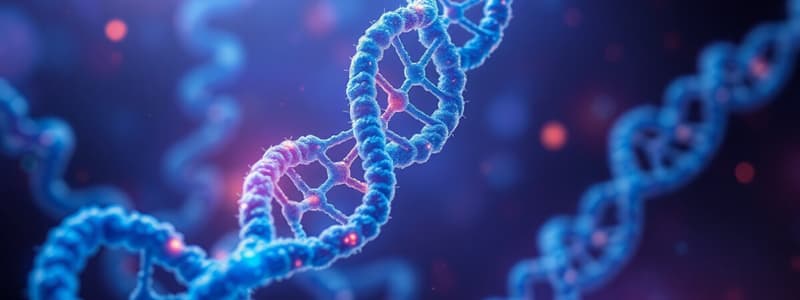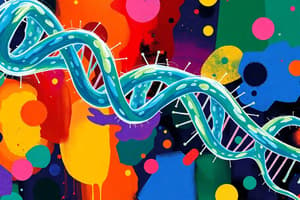Podcast
Questions and Answers
What is a characteristic of prokaryotic genes in terms of transcription termination?
What is a characteristic of prokaryotic genes in terms of transcription termination?
- Termination involves structures found on the transcript itself. (correct)
- The closest open reading frame is always the only one replicated.
- There are no untranslated regions after the termination sequence.
- Termination is solely based on the presence of a Stop codon.
Which component is not included in eukaryotic mRNA processing?
Which component is not included in eukaryotic mRNA processing?
- Transcription factors (correct)
- 5' cap structure
- Introns
- Exons
What is the primary function of RNA polymerase I in eukaryotic cells?
What is the primary function of RNA polymerase I in eukaryotic cells?
- Generate small non-coding RNAs.
- Facilitate transcription factor binding.
- Synthesize protein-coding mRNA.
- Produce ribosomal RNA. (correct)
How many stop codons are present within the genetic code?
How many stop codons are present within the genetic code?
What regulates the transcription of eukaryotic genes?
What regulates the transcription of eukaryotic genes?
What is true about the redundancy in the amino acid synthesis due to codon usage?
What is true about the redundancy in the amino acid synthesis due to codon usage?
Which of the following statements is correct regarding eukaryotic promoters?
Which of the following statements is correct regarding eukaryotic promoters?
What is a defining feature of ribosomal RNA (rRNA) genes in eukaryotes?
What is a defining feature of ribosomal RNA (rRNA) genes in eukaryotes?
What role does the CTD (carboxy-terminal domain) of RNA polymerase II play?
What role does the CTD (carboxy-terminal domain) of RNA polymerase II play?
Which of the following statements about RNA polymerase II promoters is true?
Which of the following statements about RNA polymerase II promoters is true?
What is the primary difference between the major and minor grooves in DNA?
What is the primary difference between the major and minor grooves in DNA?
Which element is NOT a core promoter region for RNA polymerase II?
Which element is NOT a core promoter region for RNA polymerase II?
Why are proteins unable to distinguish between A=T and T=A in the minor groove?
Why are proteins unable to distinguish between A=T and T=A in the minor groove?
What role does TFIIB play in transcription?
What role does TFIIB play in transcription?
What is the order of assembly for the general transcription factors during RNA polymerase II recruitment?
What is the order of assembly for the general transcription factors during RNA polymerase II recruitment?
How does the Mediator complex influence gene transcription?
How does the Mediator complex influence gene transcription?
What happens during the phosphorylation of the CTD?
What happens during the phosphorylation of the CTD?
How do enhancers affect gene expression?
How do enhancers affect gene expression?
What is the effect of having all promoter elements present in RNA polymerase II regulation?
What is the effect of having all promoter elements present in RNA polymerase II regulation?
What is the primary function of silencers in gene regulation?
What is the primary function of silencers in gene regulation?
What structural feature of RNA polymerase II allows for regulatory control?
What structural feature of RNA polymerase II allows for regulatory control?
Why is the recruitment of general transcription factors crucial for RNA polymerase II function?
Why is the recruitment of general transcription factors crucial for RNA polymerase II function?
What mechanism do insulators use in gene regulation?
What mechanism do insulators use in gene regulation?
What differentiates proteins that bind in the major groove from those that bind in the minor groove?
What differentiates proteins that bind in the major groove from those that bind in the minor groove?
Which transcription factor stabilizes the binding of TFIID and TFIIB?
Which transcription factor stabilizes the binding of TFIID and TFIIB?
Which factor is required for the binding of TFIIB at the promoter?
Which factor is required for the binding of TFIIB at the promoter?
Which groove of DNA does the TBP (TATA-binding protein) bind to, causing the DNA to bend?
Which groove of DNA does the TBP (TATA-binding protein) bind to, causing the DNA to bend?
What role does the TATA binding protein (TBP) play in transcription?
What role does the TATA binding protein (TBP) play in transcription?
Which transcription process is characterized by a formation of a transcription bubble?
Which transcription process is characterized by a formation of a transcription bubble?
What is one of the primary reasons eukaryotes have more protein coding genes compared to bacteria?
What is one of the primary reasons eukaryotes have more protein coding genes compared to bacteria?
What is a key characteristic of prokaryotic transcription termination?
What is a key characteristic of prokaryotic transcription termination?
What is significant about eukaryotic genes having multiple open reading frames (ORFs)?
What is significant about eukaryotic genes having multiple open reading frames (ORFs)?
Which RNA polymerase is responsible for producing messenger RNA (mRNA) that encodes proteins?
Which RNA polymerase is responsible for producing messenger RNA (mRNA) that encodes proteins?
What is the role of the Upstream Control Element (UCE) in RNA Pol I promoters?
What is the role of the Upstream Control Element (UCE) in RNA Pol I promoters?
What does the presence of introns in eukaryotic genes signify?
What does the presence of introns in eukaryotic genes signify?
Flashcards
Prokaryotic gene termination
Prokaryotic gene termination
Transcription stops due to specific sequences in the transcript, not a stop codon. Examples include rho-dependent and terminator structures.
Eukaryotic gene structure
Eukaryotic gene structure
Eukaryotic genes contain introns (non-coding) and exons (coding), where introns are removed. They also have regulation sequences and multiple promoters that can lead to multiple mRNAs.
Eukaryotic RNA polymerases
Eukaryotic RNA polymerases
Eukaryotic cells have three types of RNA polymerases: Pol I (rRNA), Pol II (mRNA), and Pol III (small non-coding RNAs).
RNA polymerase I promoter
RNA polymerase I promoter
Signup and view all the flashcards
Open reading frames (ORFs)
Open reading frames (ORFs)
Signup and view all the flashcards
Multiple promoters
Multiple promoters
Signup and view all the flashcards
Tandem arrays
Tandem arrays
Signup and view all the flashcards
Wobble effect
Wobble effect
Signup and view all the flashcards
Major Groove
Major Groove
Signup and view all the flashcards
Minor Groove
Minor Groove
Signup and view all the flashcards
Sequence Specificity (proteins)
Sequence Specificity (proteins)
Signup and view all the flashcards
TATA Binding Protein (TBP)
TATA Binding Protein (TBP)
Signup and view all the flashcards
TFIIB Role
TFIIB Role
Signup and view all the flashcards
Mediator Complex
Mediator Complex
Signup and view all the flashcards
Enhancers
Enhancers
Signup and view all the flashcards
Silencers
Silencers
Signup and view all the flashcards
Insulators
Insulators
Signup and view all the flashcards
Cis-acting elements
Cis-acting elements
Signup and view all the flashcards
TFIII-C and TFIII-B
TFIII-C and TFIII-B
Signup and view all the flashcards
RNA Pol II Promoter Variability
RNA Pol II Promoter Variability
Signup and view all the flashcards
RNA Pol II Core Enzyme
RNA Pol II Core Enzyme
Signup and view all the flashcards
CTD (Carboxy-Terminal Domain)
CTD (Carboxy-Terminal Domain)
Signup and view all the flashcards
Initiation of Transcription: Probability
Initiation of Transcription: Probability
Signup and view all the flashcards
Core Pol II Promoter Elements
Core Pol II Promoter Elements
Signup and view all the flashcards
Eukaryotic Transcription Cycle
Eukaryotic Transcription Cycle
Signup and view all the flashcards
TFIIA
TFIIA
Signup and view all the flashcards
TFIIB
TFIIB
Signup and view all the flashcards
TFIIF
TFIIF
Signup and view all the flashcards
TFIIE
TFIIE
Signup and view all the flashcards
TFIIH
TFIIH
Signup and view all the flashcards
Preinitiation Complex (PIC) Formation
Preinitiation Complex (PIC) Formation
Signup and view all the flashcards
What are "introns"?
What are "introns"?
Signup and view all the flashcards
Why are there "multiple promoters"?
Why are there "multiple promoters"?
Signup and view all the flashcards
What does "tandem arrays" mean?
What does "tandem arrays" mean?
Signup and view all the flashcards
What is the "wobbling effect"?
What is the "wobbling effect"?
Signup and view all the flashcards
What is the role of "Pol I"?
What is the role of "Pol I"?
Signup and view all the flashcards
Study Notes
Nucleic Acids
- Prokaryotic genes have a promoter region, open reading frames (ORFs), and a termination signal.
- The termination of transcription in prokaryotes is not solely dependent on a stop codon but also involves termination structures within the transcript itself.
- Prokaryotic transcripts contain 3' untranslated regions (3' UTRs) after the termination sequence.
- Multiple ORFs can exist, with the one closest to the promoter region often being preferentially replicated.
Eukaryotic genes
- Eukaryotic mRNA contains both introns (non-coding) and exons (coding regions) that need to be edited. The introns are removed during processing.
- Regulation sequences (800-1000 bp) are present downstream from the promoter.
- There can also be upstream regulatory elements and overlapping reading frames.
- Multiple promoters in a single gene can generate diverse mRNA transcripts.
Eukaryotic Genes: 3 Specialized Polymerases
- Pol I: Produces ribosomal RNA (rRNA). Cells need these consistently in high amounts.
- Pol II: Produces messenger RNA (mRNA) and some non-coding RNAs like miRNAs.
- Pol III: Produces small, highly abundant non-coding RNAs, like transfer RNA (tRNA), 5S rRNA, and 7SL RNA.
RNA Polymerase I Promoter
- Contains an upstream control element (UCE) and a core promoter element (CPE).
- Little variation in rRNA promoters within a species, but many copies exist, especially in eukaryotic chromosomes.
- rRNA genes are organized in tandem arrays for consistent high-level production.
Initiation of Transcription (Pol I)
- UBF (upstream binding factor) binds to the UCE and core sequence.
- SL1 (selectivity factor 1) binds to UBF, and the Pol I complex is formed.
- TATA-binding proteins (TBPs) can bind to all three polymerases.
- The rapid recycling of Pol I allows for the synthesis of large amounts of rRNA from one tandem array to another.
RNA Polymerase III promoter
- Promoter structure is more diverse and complex than Pol I promoters.
- Production can vary based on regulation, producing different RNA transcripts at different times based on the needs of the cell.
- Specialized in producing smaller, highly abundant non-coding RNAs like tRNA, 5S rRNA, 7SL RNA, and U6 snRNP.
RNA Polymerase II promoter
- The most diverse and complex control mechanism of the three polymerases.
- Expression levels can vary greatly (10,000-fold) in response to stimuli.
- Some genes consistently express at high levels while others are expressed only under specific conditions.
- Eukaryotic cells have far more protein-coding genes (∼20,000).
RNA Polymerase II structure
- RNA polymerase II core enzyme has 12 subunits, some with bacterial homology.
- The carboxyl-terminal domain (CTD) of the tail is important for regulating the enzyme's activity and it can be modified by phosphorylation.
RNA pol II core promoters
- Elements like BRE (TFII-B Recognition Element), TATA box, INR (Initiator), and DPE (Downstream Promoter Element) affect the specificity and strength of transcription.
Eukaryotic Transcription Cycle
- Processes include PIC (pre-initiation complex) formation, bubble formation, initiation, elongation, termination, and recycling, including CTD dephosphorylation.
- General transcription factors are required for initiating Pol II transcription.
Core promoter structure and function
- Enhancer sequences are important in regulating transcription.
- General transcription factors like TFII-D, TFIIA, TFII-B, TFIIF, TFIIE, and TFIIH play essential roles in assembling the pre-initiation complex on the DNA to recruit and bring in the correct polymerase for transcription.
Mediator complex
- Integrates signals from enhancers and activating proteins.
- Binds to the RNA polymerase II complex to control transcriptional activity.
Insulators
- Binding proteins limit the effects of enhancers to specific genes/regions to prevent unwanted transcriptional activation.
Studying That Suits You
Use AI to generate personalized quizzes and flashcards to suit your learning preferences.




